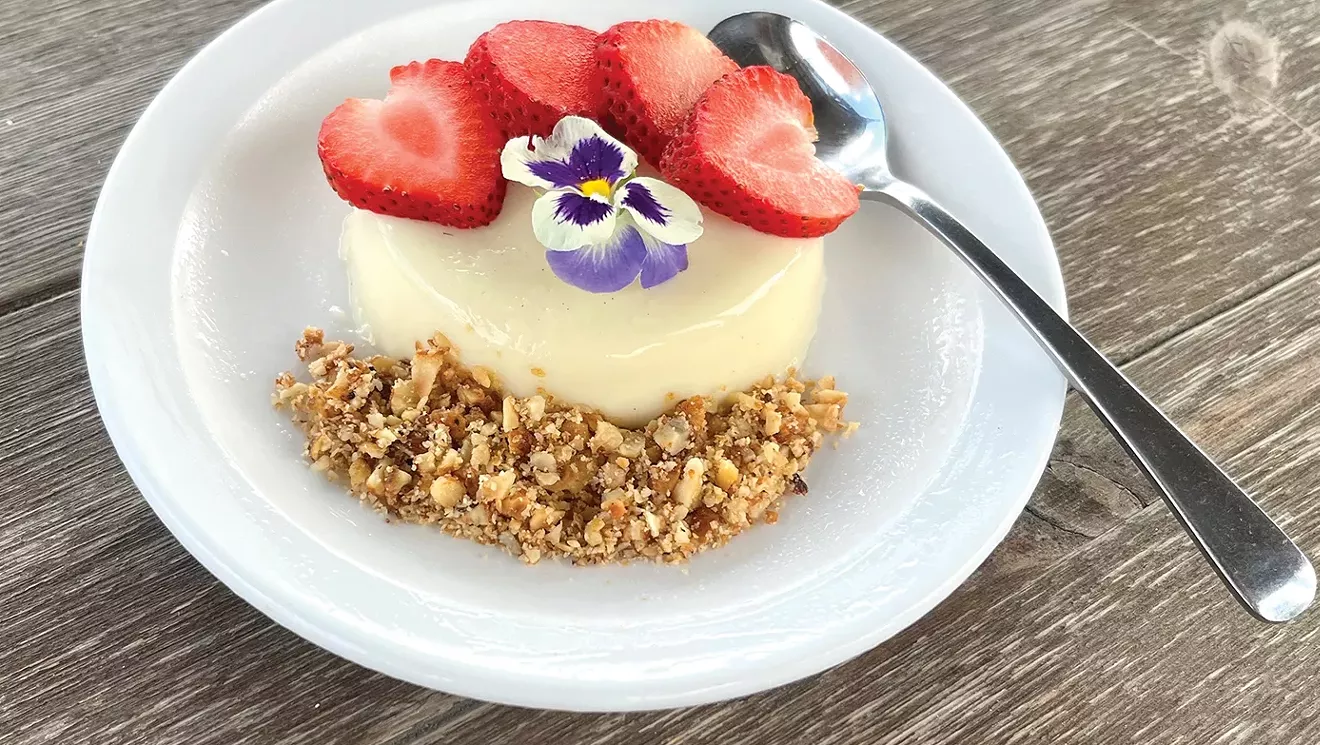
Photo by Peter Glatz
Honey panna cotta. A panna cotta can be topped with seasonal fruit and served with something crunchy such as brittle, chopped nuts or cookie crumbs.
Panna cotta, meaning “cooked cream” in Italian, is a wobbly, silky, eggless custard-like dessert made with sweetened cream bound with gelatin. It’s one of my favorite make-ahead desserts, especially when I need to use up leftover dairy products in the refrigerator. A panna cotta is pretty easy to make, and it lends itself to improvisation. Its cream can be infused with various seasonings or flavoring agents, such as vanilla or cinnamon sticks, and different types of dairy, such as buttermilk, can be used as a substitute. A panna cotta can be topped with seasonal fruit and served with something crunchy such as brittle, chopped nuts or cookie crumbs, which provide a nice textural contrast. Moreover, a panna cotta doesn’t have to be limited to desserts. I’ve made savory versions with pureed cauliflower and even smoked bone marrow. A special benefit is that panna cotta can be prepared the afternoon before serving or made ahead and stored in the refrigerator for up to a week, making it an excellent choice for entertaining.
Gelatin, the ingredient that binds a panna cotta together, is available in two forms: powdered (or granulated) and in sheets (called leaf gelatin). Leaf gelatin is generally preferred in restaurant kitchens, while powdered gelatin in pre-measured envelopes is most commonly used in home kitchens. It should be noted that “gelatin” is the preferred American spelling, while “gelatine” is the spelling used in the U.K. However, Knox, the most common brand in the U.S., uses the spelling “gelatine” on its label. An envelope of Knox Original Unflavored gelatin weighs approximately ¼ ounce, or slightly more than 7 grams, and measures out to about 2 ¼ to 2 ½ teaspoons. If your recipe calls for packets, use packets of gelatin for accurate measurement. If the recipe calls for a certain number of teaspoons, open the packets and measure the gelatin granules using a measuring spoon. Generally, one envelope of gelatin will set two cups of liquid firmly, enough to unmold a dessert. If a runnier texture is desired, the amount of gelatin can be decreased.
Before being added to the panna cotta mixture, the gelatin needs to be hydrated or “bloomed.” Blooming is the process of hydrating the gelatin in cold liquid before dissolving it in hot liquid. It involves sprinkling powdered gelatin evenly over cold water in a wide bowl or submerging sheets in cold water. After 5 to 10 minutes, the gelatin will have absorbed all the water and developed a thick, gelatinous appearance.
Though panna cotta is relatively easy to make, a few problems might arise. If the dairy and gelatin mixture accidentally comes to a boil, the gelatin’s thickening power is reduced. The mixture should be heated only enough to give off steam, not form bubbles. The target texture is “wobbly,” not too firm or too runny.
It is helpful to cool the mixture in an ice bath, whisking it occasionally. If the mixture is placed in the refrigerator while still warm, it may separate.
Honey panna cotta
Serves 6
Ingredients:
2 ¼-ounce envelopes of powdered unflavored gelatin
cup cold water
2 cups of milk
2 cups heavy cream
½ cup sugar
½ cup honey
1 teaspoon vanilla extract
Preparation:
Wipe the insides of 6 (one-half-cup) ramekins with a light coating of neutral oil. Arrange on a sheet tray and chill. Alternately, if you don’t plan to unmold the panna cottas, you can go straight into ungreased ramekins or parfait glasses.
Fill a large bowl with ice and add enough water to create an ice bath; set it aside.
To bloom the gelatin, place cup of cold water in a shallow, wide bowl and sprinkle the gelatin evenly over the surface. If areas of dry gelatin remain, add a little more water and gently tilt the bowl to moisten thoroughly, but do not stir. Set aside to bloom for about 5 to 10 minutes.
In a medium saucepan over medium-low heat, gently heat the milk and cream, along with the sugar and honey, until they reach approximately 194 degrees F, just below a boil. Remove from the heat and whisk in the vanilla extract and bloomed gelatin until dissolved. Set the saucepan in the ice bath (making sure the top of the saucepan is well above the surface of the water), and continue to whisk until the mixture is lukewarm, 105-110 degrees F. Test the mixture by rubbing a little bit between your fingers. There should be no grit from undissolved sugar or gelatin. Strain through a fine-mesh strainer into a spouted measuring bowl.
Ladle or pour the mixture into oiled ramekins or parfait glasses and refrigerate for a minimum of six hours or preferably overnight. If storing longer than overnight, gently press plastic wrap directly onto the panna cotta’s surface to prevent a skin from forming.
When you’re ready to serve, about 10 minutes beforehand, carefully trace the inside edge of the ramekin with a thin knife. Dip the ramekin briefly into hot water, then invert it onto a serving plate. If the panna cotta doesn’t come out right away, tap the ramekin gently on the countertop to help loosen it. If it’s still stuck, dip it in hot water for an additional five seconds and try again. If preferred, panna cotta can be served in the ramekin or parfait glass, eliminating the need for unmolding.
Top with berries or fruit preserves, and a crunchy topping if desired.
Panna cotta can be made ahead and stored in the refrigerator for up to one week. Freezing panna cotta is not recommended because it changes its texture.


